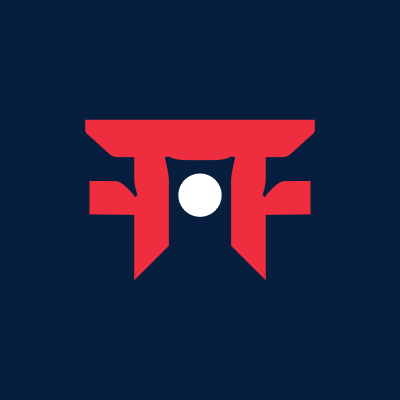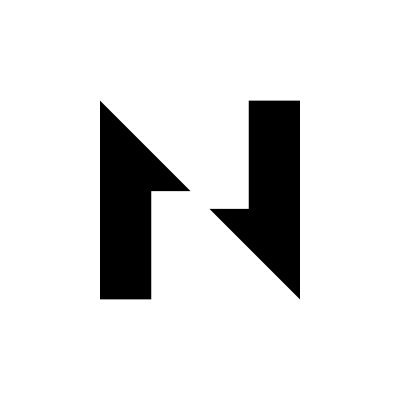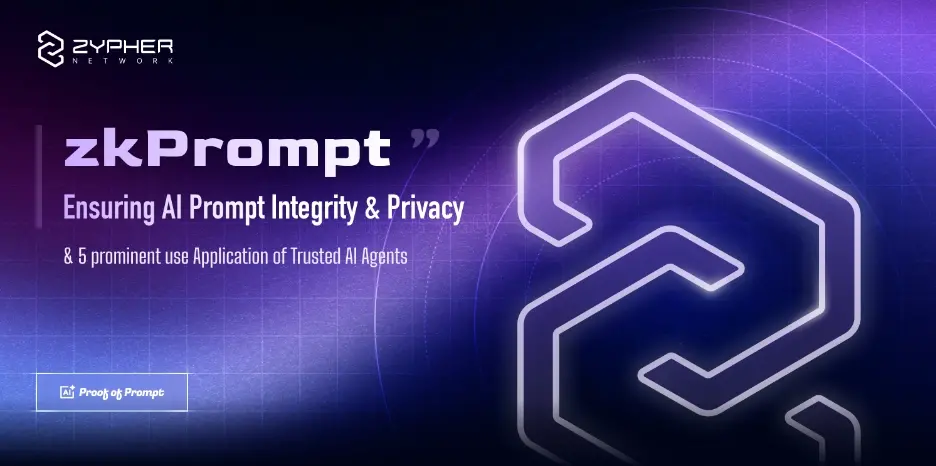From narrative to original language, the three design paradigms of the full-chain game engines Mud, Dojo, and Zypher
Author: NingNing
Are autonomous worlds / full-chain games just boring toys for crypto enthusiasts? Or are they a type of cult meme?
These questions arise due to the complex and abstract definitions of autonomous worlds / full-chain games, combined with the currently simplistic and rudimentary game interfaces and interactions, which deter most gamers.
However, in reality, while autonomous worlds / full-chain games offer a gaming experience completely different from other paradigms, it does not mean they are not fun. As an experienced gamer, the first full-chain game, DarkForest, was the only game I played continuously for two days straight in the past five years.
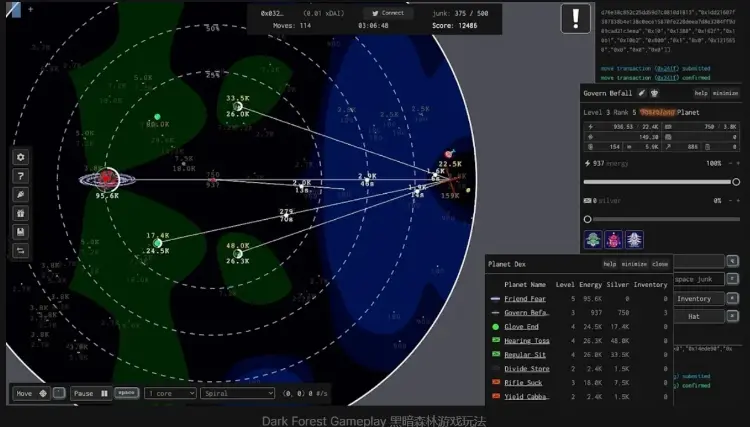
If other games exist in a sandbox space where the content simulates escape room games, then the space of full-chain games is a digital physical reality, and the content of full-chain games simulates real-world games. While playing DarkForest, I truly experienced the cosmic horror that permeates Liu Cixin's "The Three-Body Problem."
The Basic Narrative of Autonomous Worlds / Full-Chain Games
The Lattice team established the connotation and extension of the concept of autonomous worlds / full-chain games in the "Declaration of Autonomous Worlds," distinguishing them from Web2.5 games.
Autonomous worlds / full-chain games are self-sustaining open game systems based on digital physical reality and fundamental laws, characterized by persistence, immutability, and permissionlessness.
Narrowly defined full-chain games refer to autonomous worlds, where playability does not stem from game content (such as worldview, plot, music, character art, etc.) or a sense of game objectives (like levels, achievements, dungeons, or national wars), but from the real experiences players have in the sub-worlds constructed within the autonomous world.
The construction logic of autonomous worlds / full-chain games is object - fundamental laws - digital physical reality, corresponding to the entities - components - systems in the ECS framework of game engines.
In a sense, autonomous worlds / full-chain games explore the construction of a new layer of virtual worlds based on the information bits of our real world. Or, as Musk puts it, a new virtual world nested within a virtual world. This is consistent with the iconic scenes of infinite recursive nesting in the sci-fi animated series "Rick and Morty."
Implementation Paradigms of New Primitives in Autonomous Worlds / Full-Chain Games
The above is a simplified narrative of autonomous worlds / full-chain games. To instantiate the narrative of autonomous worlds / full-chain games, we need a complete set of new primitives composed of engineering modules such as blockchain, game engines, middleware, and game clients.
The new primitives of autonomous worlds / full-chain games need to address three core issues:
- The scalability issue of blockchain. To achieve the persistence, immutability, and permissionlessness of autonomous worlds / full-chain games, all game states and logic must be on-chain, which places very high demands on the scalability and programmability of the blockchain.
- The tick loop issue. The blockchain is a sequential state machine along the arrow of time, which is not suitable for managing the states of autonomous worlds / full-chain games. This is because autonomous worlds / full-chain games have a large number of cyclical events, such as sunrise and sunset, and the patrol routes of minor monsters. Moreover, the blockchain updates states passively, requiring users to send transactions to trigger events.
- How to achieve the immutability of digital physical reality while maintaining the openness, permissionlessness, and ability to add, query, modify, and delete fundamental laws and objects.
In response to these three core issues, the teams of autonomous worlds / full-chain games, including Lattice, Dojo, and Zypher Games, provide different solutions.
The primitives of Lattice's autonomous worlds / full-chain games consist of the Worlds development framework, MUD game engine, and Redstone underlying consensus protocol.
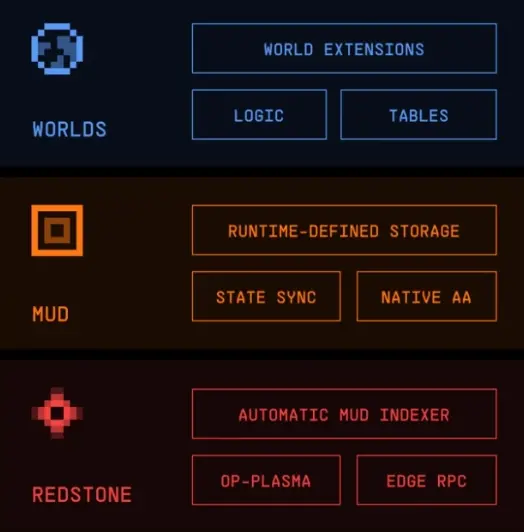
World Development Framework. World is a smart contract development framework built on the new storage engine STORE of MUD V2. STORE is a storage engine defined by Runtime. MUD V2 replaces the storage model of the Solidity compiler with it.
World represents a new paradigm for EVM applications. You can think of it as a community computer: it exists as a multiplayer game kernel, accepting contributions from anyone on-chain—whether code or state.
World features programmable access management, allowing any state or logic to control which accounts (or other logic) can access them. This enables the establishment of trust hierarchies and allows untrusted smart contracts to read states and participate in rules without directly writing to storage.
MUD Game Engine. The MUD full-chain game engine is the first full-chain game engine in the EVM ecosystem. MUD V2 consists of the storage engine STORE defined by the runtime, state synchronization, and a native AA (account abstraction) module.
The new features of MUD V2 allow for the creation of a set of digital physics that determine how the world is created and transformed, and subsequently destroy root access to itself; all while adhering to a set of normative rules without limiting the functionality: anyone in the world—humans and machines—can interact with these rules and build societies and engineering devices on top of them.
Redstone Underlying Consensus Protocol. Redstone is the first Plasma Rollup L2 instance of the OP Stack, built in collaboration between Lattice and Optimism specifically for developers of on-chain games and autonomous worlds.
Its operation is similar to traditional OP Rollups, but unlike OP Rollups that publish input states to L1, Redstone only publishes a data commitment hash. The input states corresponding to the input commitment are stored off-chain by data availability providers. To ensure the availability of the input states corresponding to the input commitment, there is a data availability challenge contract on L1 that allows anyone to challenge the data commitment in case the provider has issues.
Dojo was initially a fork project of MUD, dedicated to implementing MUD on Starknet using the Cairo language. The current primitives of Dojo's autonomous worlds / full-chain games consist of the Cairo state and smart contract development framework, the full-chain game engine SOZO CLI, the indexing and RPC service middleware TORII, and the KATANA underlying consensus protocol.
Cairo State and Smart Contract Development Framework. Dojo provides a standardized approach to building full-chain games / autonomous worlds using Cairo smart contracts, simplifying the development process and allowing developers to focus on logic rather than architecture.
Full-Chain Game Engine SOZO CLI. SOZO CLI supports the creation, building, testing, and deployment of full-chain game / autonomous world instances, enabling the creation of new components and systems and assisting in managing multiple autonomous world instances.
Indexing and RPC Service Middleware TORII. TORII automatically indexes all contract states. It automatically exposes states via GraphQL API or gRPC. Developers no longer need to generate custom indexers.
KATANA Underlying Consensus Protocol. KATANA is a customizable Starknet development network that allows for rapid iteration of game logic.
The main difference between Dojo and MUD lies in the use of ZK-Rollup as the underlying consensus protocol and the Cairo language as the development language.
Unlike the adaptive specialization development path of the full-chain game / autonomous world engine forked from MUD, Zypher Game is a fully native full-chain game / autonomous world engine based on ZK technology. The primitives of Zypher Game's full-chain game / autonomous world consist mainly of the game engine Secret Engine, AW Engine, and the underlying consensus protocol Zytron Kit.
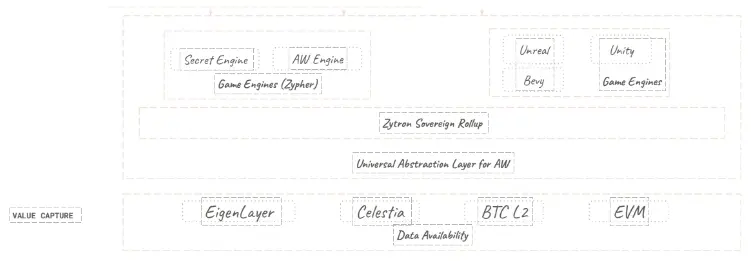
Secret Engine provides a set of zk-driven SDKs that can securely execute verifiable cryptographic computations, ensuring that the elements required by the game remain sealed on-chain. The existing service zk-shuffle-as-a-service has already assisted over three full-chain card games with encryption and shuffling.
AW Engine. AW Engine consists of various ZK-driven services SDKs, including Gadgets toolbox, APP-specific circuits, on-chain verification nodes, etc. AW Engine enables plug-and-play ZK functionality, the composability of ZK circuits, and integration with third parties and the RISC Zero ZK virtual machine.
AW Engine has also innovatively developed the Z4 engine specifically for multiplayer real-time games. Z4 expands the concurrency of multiplayer games through zk-rollup, focusing on a rapid way of state changes. Z4 allows games to avoid global state broadcasting on the source chain and instead transform into inexpensive local state changes, effectively reducing user transaction fees and supporting millions or even billions of TPS.
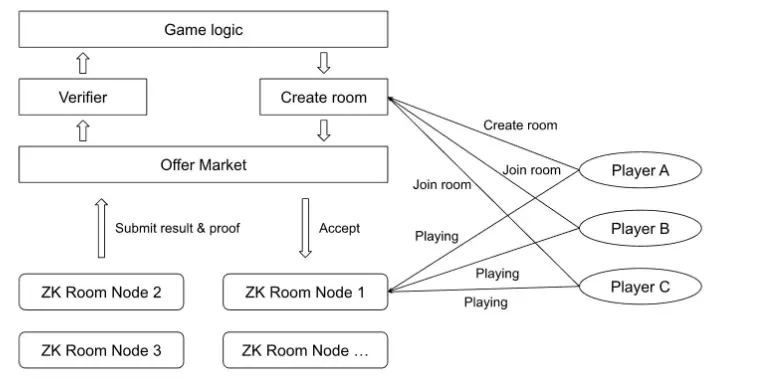
Zytron Kit. Zytron Kit is a modular Sovereign L3 Rollup building stack. Zytron Kit consists of a sovereign L3 Rollup, Zypher Games' game engine as precompiled contracts, server sharding, data compatibility, and customizable networks.
Zytron Kit is tailored for developers to build autonomous worlds, mini-strategy games, or migrate AAA games on-chain at the lowest cost, without a steep learning curve, enabling them to migrate assets, game logic, and data storage on-chain while retaining production-grade UE.
In addition to AW Engine and Zytron Kit, Zypher Game also features a proof-of-computation market aimed at mobile gamers, and Zypher is integrating with some game-related infrastructures.
Recently, Zypher Game has also reached collaborations with Risc Zero and Celesita. In the collaboration with Risc Zero, Zypher Game integrates Risc Zero's general ZK virtual machine into the Zypher game engine and extends functionality through the included game-specific SDK, expanding Risc Zero's use cases. In the collaboration with Celesita, Zypher Game uses Celesita's Roll Kit tools to build Zytron Kit and makes Celesita the default DA layer for Zytron Kit.
Recently, Zypher Games launched the B² Network testnet, indicating support for the BTC ecosystem and plans to help the BTC ecosystem develop on-chain games through ZKP and AI technologies.
Conclusion
From narrative to primitives, to address the scalability issue of blockchain, the tick loop issue, and to achieve the immutability of digital physical reality along with the openness of fundamental laws and objects, the new primitives of autonomous worlds / full-chain games provide different solutions. Lattice chose the path of OP-Rollup + modified EVM consensus state mechanism, while Zypher Game and Dojo opted to use ZKP to trustlessly compress state data and transfer verification to off-chain computation.
Each of the three solutions has its strengths. Lattice's implementation paradigm has advantages in EVM compatibility and developer friendliness. Dojo Game adapts to the development environment and ecological specificity of Starknet. Zypher leverages modular DA, RiscZero ZK co-processors, and the native digital physical characteristics of Bitcoin UTXO to achieve a solution that combines trustlessness, scalability, and performance elasticity.
In addition to these three paradigms, there are also Argus's World Engine and Nervous (CKB)'s full-chain game / autonomous world primitives based on eUTXO state data structures.
Currently, full-chain games / autonomous worlds are in the technological budding stage of the Gartner emerging technology growth curve, where the number of developers exceeds that of players, and many test games resemble 4399-like casual games. This does not deter crypto venture funds from making significant investments in this emerging field. In their eyes, the current state of full-chain games / autonomous worlds is akin to trains in the 1820s that could not outrun horse-drawn carriages—not a problem, but an opportunity.






